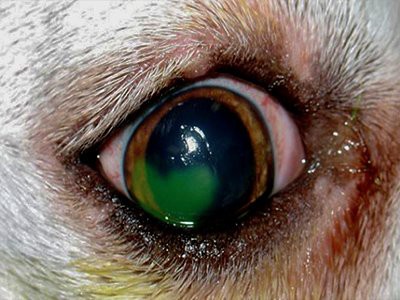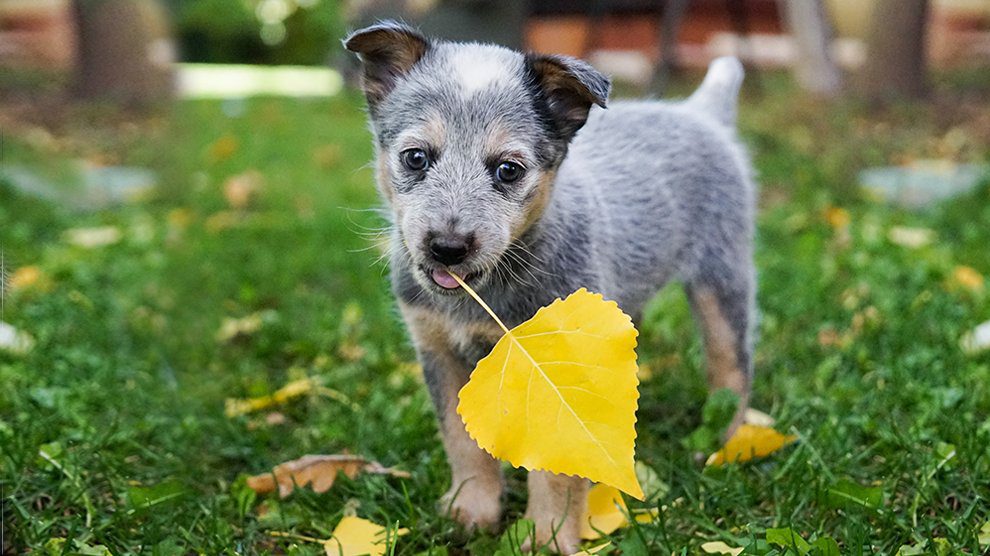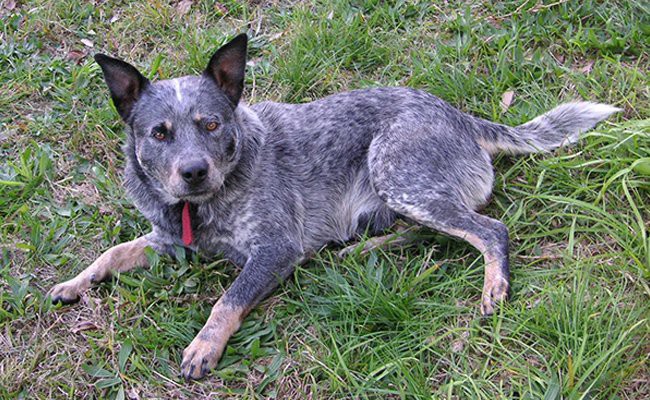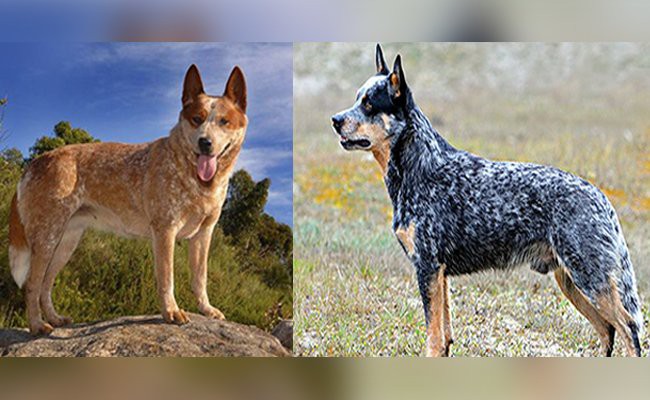Dog Pregnancy Calculator And Timeline
Blue Heeler or the Australian Cattle Dog is a hardworking, intelligent, and active dog. The strong and agile Blue Heeler Puppy is always alert and with a keen-to-work attitude even from a young age.
This herding dog breed is developed in Australia to drive the cattle along the terrain. It is very often related to the popular wild dog, Dingo.
It is taller than medium and stands between 17 to 19 inches at the shoulder.
The Blue Heeler is born white and as it gets older the blue or red specking patterns feature.
They need to be kept active as they are energetic dogs. They work better than humans most of the time. Australian Cattle Dogs are highly devoted to their owners and protective of their family. Their loyalty makes them very sincere and better workers.
These are very lively and happy dogs and always interested to do some activity.
Australian cattle dog is a modern version and there was a predecessor for this breed that was introduced by Thomas Hall, an Englishman during 1840.
Blue Heeler Breed Info
- Origin: Australia
- Size: Medium Dog
- Dog Breed Group: Working Dog, Herding Dog
- Purebred: Yes
- Lifespan: 13 – 15 years
- Height: Male: 46–51 cm, Female: 43–48 cm
- Weight: Male: 15–16 kg, Female: 14–16 kg
- Coat Appearance: Short double coat
- Coat Colors: Blue, Red, Blue-Gray
- Temperament: Active, Affectionate, Loyal, Intelligent, Alert
- Good With Children: Fare
- Intelligence Level: Good
- Good With Pets: Yes
- Hypoallergenic: No
- Grooming: Yes
- Shedding: Yes
- Barking: They Don’t bark much
- Suitable For Apartments: No
- Need For Exercise: Yes
- Easy To Train: Yes
- Good For First Time Owners: Yes
- Health Issues: Hip Dysplasia, Deafness, Progressive Retinal Atrophy, Liver Shunt
- Litter Size: 1 to 7 Puppies, 5 (average)
- Average Price: $500 to $1200
What Does A Blue Heeler Look Like?
This medium-sized sturdy dog has muscular legs, a solid neck with a rounded head, and pointed ears. Blue Heelers have curved and droopy tails. The eyes are oval and dark with an expression of alertness all the time. Usually, the foot appears round and arched with bulky toes and nails.
Blue Heeler Colors
This short-coated dog has weather-resistant blue, blue speckled or red speckled brown or black hair. They named Australian Cattle dog as Red heeler or Blue Heeler based on the brown or black hair spread over the white hair.
Both the varieties display distinct color flecking patterns. It has a good muscular build with strong shoulders and muscles and a broad skull.
Are Australian Cattle dogs hypoallergenic?
No, they are not hypoallergenic. They shed throughout and do the blow away twice a year when triggered. Actually, all dogs shed and 100 percent hypoallergenic is hypothetical. People who are allergic to pets should take this to concern if they want to buy a Blue Heeler puppy.
Blue Heeler Origin
The Blue Heeler Puppy was originally developed to move livestock over long distances. They were used to drive the cattle over a long stretch in an open country.
The Australian Cattle dogs have the ability to work hard even in any disturbing hot climate. They go on to bite the intruders and strange movers silently.
Now, coming over to how it was developed, you have to know about a cattle farmer named Thomas Hill.
It is claimed that to get a sturdy and hardworking herding dog, he created the heeler dog from Dingo and Sheepdogs.
Thomas hall’s dogs were called Hall’s Heelers during the 1840s. It is also reported that another farmer called George Elliot also experimented on the same and created the Australian Cattle Dogs.
While they always connect Thomas hall’s name with the Australian Cattle Dog, another name involved is Robert Kalesky.
Blue Heeler Kennel Club Recognition
The Australian Cattle dog is now formally called as Blue Heelers. This breed was accepted by the Kennel Club Of NSW in 1903 as an Australian Heeler.
The American Kennel Club and Canadian Kennel Club recognized this breed only during 1980. United Kennel Club, Australian Kennel Council, and few other kennel clubs also accept this breed.
Temperament Of Blue Heeler
Blue Heeler Dogs make awesome pets if you provide them with regular exercise. To stay healthy and happy, they require systematic physical activities and mental stimulation.
Are Blue Heeler dogs good pets?
They are devoted to their masters and are a pack of great personalities and love. However, they have the worst reputations amongst other breeds for biting people. Usually, they behave well with children.
If ill-treated at any time, it will turn on them and start to attack. They must be socialized at a very young age; else, it will become much destructive. Early socialization will make them an excellent family dog.
The Australian Cattle dog is an active and energetic dog loves to run and play with kids.
Size Of Blue Heeler
The average height of a male and female Blue Heeler dog ranges between 46-51 cm and 43-48 cm.
The normal weight of a male and female dog of this breed is somewhere between 15 kg to 22 kg.
How long does Blue Heeler live?
The average longevity of a Blue heeler dog is between 10 to 13 years. Highly healthy and happy dogs live for a couple or more years.
Therefore, it is very vital to note that the surroundings and food has a key role in determining the health of a dog.
Blue Heeler Food Intake
The Blue Heeler can live off a very limited diet.
It is very important for owners to keep an eye on their dog’s weight to ensure they are healthy size.
Good quality kibble, fed twice a day (once they have reached adulthood), once in the morning and once in the evening is perfectly adequate for this breed.
This pooch will typically eat around three cups of kibble each day.
Working Heelers may require a food that is richer in protein, in order to fuel their energy levels.
Blue heelers can live with a limited, healthy diet. The owners must give importance to the dog’s weight, as obesity will hinder their agility. Feed him with good quality dog food twice a day and that will very much go with them. You can feed them three cups of kibbles daily divided for two times.
Australian Cattle Dog Food Amount
If your dog works a lot, then he will need more energy. You have to feed him high protein and hardy food to keep him at his charge.
As the high-energy Australian Cattle dog is claimed to be a descendent of Dingo, the diet must be exceptional to keep up his DNA.
He needs a complete and planned diet that abide by the standards of AAFCO (The Association of American Feed Control Officials). Make sure to look out for the endorsement of AAFCO at the back of the pack before you buy it.
Also, as with other dogs, you must avoid feeding your canine with toxic foods like grainy foods, corn, soy, wheat, dairy Products, Raw chicken eggs, chocolates, pork from a leg cut, almonds.
However, there are certain human foods that can be given to your Blue heeler. You can feed him brown rice, the best meat that is obtained from early maturing, tuna fish, and chicken (cooked). Vegetables with Vitamin A and antioxidants like carrots and beans, leafy greens like spinach leaves and lettuce. dairy products like yogurt and cottage cheese can also be given. You can feed him treats like sweet potatoes which promote healthy digestive systems due to their dietary fiber content.
Fruits that can be minced such as apples, high fiber bananas, watermelons, and citrus fruits like oranges can also be given.
Red Heeler vs Blue Heeler
| Red Heeler Dog | Blue Heeler Dog |
|---|---|
| In fact, Queensland Heeler dog breed with a brown color coat is referred to as Red Heeler | The similar breed of dog with a black or grey coat is called as a Blue Heelere Heeler |
| The body of red heeler dog is completely speckled with red markings | The body of a blue heeler dog can either appear in blue, blue mottle or blue speckled with or without black, tan or white markings |
Blue Heeler Puppies
Generally, Blue Heeler puppies are born white. However, as they grow the coat color changes to blue or brown hair spread over the white hair with distinct specking patterns. The litter size will range from 1 to 7.
Like other puppies, the blue Heeler puppies will also be ready for adoption at around eight weeks of age. Normally, a Blue Heeler puppy will take around eighteen months of time to mature and be like a developed dog.
The puppy will weigh around 14lbs at three months and in a year it will weigh between 30lbs to 50lbs. They do not bark much and are quiet ones except when excited.
They are not that friendly with other dog breeds. However, early socialization will make them a compatible and friendly puppy with other canine friends.
How much should I feed my Blue Heeler puppy?
The amount of food you give depends on the size of the puppy and the activity level. Normally, you can feed 3/4 cup of kibble 3 times a day till he is 10 months old starting from 4 months. After 12 months, feed him regular dog food twice a day.
How To Train Blue Heeler?
Blue heelers are known for possessing an exorbitant amount of energy. These active dogs are always on the wait for works. Australian Cattle Dogs are very loyal and hard-working and need to be given proper exercise and activities for at least two hours a day.
They are very obedient and protective of their owners largely. Blue Heeler will be a happy and playful dog if trained properly from a young age and must be kept active mentally and physically.
These agility activities will definitely from unwanted and inappreciable behaviors. Blue Heelers are quick learners and ready for tough works. They like water and love to swim as well.
Blue Heeler Fun Facts
Blue Heeler dog is a descendant of Australia’s popular Dingo dog breed.
Interestingly, it stands in the #10 position of smartest dog breeds.
Blue Heeler Puppy has many nicknames like Australian Cattle Dog, Red Heeler, Queensland Heeler, and Australian Heelers.
In particular, Guinness Records named Bluey, a dog which comes under the blue heeler dog breed as the oldest dog to have lived in this world. The dog lived for 29 years and 5 months.
Moreover, the white patch present on a Blue Heeler’s head is known as “Bentley Mark”. The name Bently refers to an ancient dog breed named after Thomas Bently.
In 1980, Blue Heeler was recognized by the AKC as a standard dog breed. However, in 1903, the Australian Kennel club had accepted it as a standard breed.
Blue Heeler Names
Naming your Blue Heeler puppy is an exciting and interesting venture. Blue Heelers are cautious and intelligent dogs. They have their own set of rules. We have compiled some brilliant names for your Australian Cattle dog puppies.
Blue Heeler Male Names
- Blake
- Charlie
- Dale
- Eddie
- Freddie
- Harry
- Jack
- Milo
- Otto
- Ted
- Troy
- Wade
Blue Heeler Female Names
- Abbie
- Annie
- Bella
- Clare
- Ellie
- Frankie
- Grace
- Harley
- Jo
- Meg
- Rose
- Sky
Blue Heeler Health Problems
Blue heelers that are taken care of well by affectionate owners can have a comfortable life from 10 to 13 years. Australian Cattle are susceptible to a few medical conditions.
1. Hip Dysplasia
Symptoms
- Avoidance of some daily activities
- Lameness in the hind limb
- Feeling difficulty in running, jumping and climbing the staircase
- Narrow stance
- Loss of muscle weight in the thighs
- Reduced level of hip movement
- Bunny Hopping
- Expanded shoulder muscles due to the heavy transfer of weight to the front legs
- Pain in the hip joints
Causes
- Genetic disorder
- Poor nutrition
- Injury
- Weight gain
- Obesity
Treatment
Based on the stage of hip dysplasia than a Blue heeler dog is suffering, the vet gives the required treatment.
- Modified Diet – The vet will initially start treating an affected dog by recommending its owner to give a nutritious diet and effective exercises. Reducing pain is the highest priority. Factors like age, breed and the level of hip dysplasia will be studied by the vet firsthand before recommending good nutrition and exercises.
- Giving Oral Supplements – Doctors recommend oral supplements such as Glucosamine and Chondroitin for dogs with osteoarthritis. These drugs are safe and helpful for the dog in properly maintaining its joints. The two supplements will supply the building blocks required for forming the joint cartilage and also prohibit damaging enzymes.
- Physiotherapy – The purpose of physiotherapy is to ensure that the loose joints become firm and builds muscle mass. Generally, swimming is recommended as a safe and low-risk therapy.
- Recommended usage of NSAIDS – Vets recommend and treat moderate to severe stage hip dysplasia dogs with non-steroidal and anti-inflammatory drugs. It is necessary to periodically monitor the liver’s functioning while using these drugs.
- Surgery – After taking into account factors like age, size, level of activity and extent of damage suffered by your dog, the vet would recommend if thought as fit, to undergo surgery.
2. Deafness
Symptoms
- Difficulty in waking up
- Show a sense of astonishment after wakeup
- Extreme Barking
- Unresponsive to sounds of clapping and squeak sound of toys
- Not responding to doorbell noise and other loud noises
- No response when you call the name
- No response even if its owner enters the room
- Remain unresponsive to the barking sounds of other dogs
Causes
Deafness might occur in dogs due to congenital (birth) or acquired
- Congenital – Defects in the ear or nervous system due to genetically inherited disorder
- Acquired – Affected by pain or infection, blockage of the ear canal and degeneration of the geriatric nerve
- Other Reasons For Deafness may be:
- Infection – Bacterial or yeast infection formation in the inner, outer or middle ear
- Inflammation – Swelling caused in the ear or eustachian tube
- Ear Tumor – Tumor of the ear or Eustachian tube
- Exposure to heavy metals – When exposed to mercury, lead or arsenic, it can face severe hearing loss
- Toxicity of drugs – Some toxic drugs such as say, for example, ethanol and erythromycin could lead to side effects like deafness
Treatment For Hearing Loss in Dogs
It depends on the kind of hearing loss suffered by the dog: congenital or acquired.
- Permanent Deafness – Congenital hearing losses are difficult to cure. vets perform some minor corrections in the middle ear through surgery. Exposure to loud noises, drug toxicity and exposure to metals will cause severe and permanent deafness.
- Vets Recommend use of hearing aids –Vets may recommend hearing aids but dogs do not feel comfortable to use the hearing aid. Apart from this factor, a hearing aid is costly.
- Treatment for Infection – Based on the severity of the infection, a vet could recommend topical treatment and ointment for a few weeks and some antibiotics, if required. Topical ointments will show good effect within a short time on the dog. Likewise, wax-based medication could be done in the vet clinic for dogs that are not subject to ear cleaning at home.
- Eviction of foreign bodies found inside the ear – Clearing the wax out of the ears and pulling out some overgrown hairs. The vet will look out for any injury in the ear canal and then involve incomplete cleaning of the ear/s if required.
- Tumors of the Ear – Vets prefer surgical methods to free the ear canal from tumors and ensure the smooth flow of sound
3. Progressive Retinal Atrophy

Symptoms
- Decreased level of vision in dim light
- Slow response of pupils to light
- Bumping into wall or furniture
- Stumbling over objects
- Minimal response to disturbances
- Cloudiness on the surface of the eyes
- Formation of cataract on the retina
- Greenish shine to the eye
- Reluctance to climb and alight the staircase
Causes
Degeneration of tissue causes this hereditary disease and it affects the retina. The autosomal recessive gene carried by a parent is the cause of PRA (progressive retinal atrophy.
This gene can attack the newborn puppies despite the parent not being affected by PRA.
In the veterinary profession, the respective professionals state that mostly when the dogs are between 6 to 8 years of age they face the big risk of getting this disease.
Treatment
Progressive retinal atrophy (PRA) is a progressive disease and you can detect the disease only in its final stage. It is a very difficult disease to detect quickly, in the initial stage.
There is no cure guarantee for the dog since even surgery could cause post-surgical complications like the development of glaucoma. Until now, there is no effective treatment for the cure of PRA in dogs.
Overall, maintain a similar environment to help your dog.
4. Liver Shunt
Symptoms
- Lethargy
- Ataxia (coordination problem)
- Abnormal vocal
- Weakness
- Circling
- Head pressing
- Drooling
- Excessive Thirst
- Frequent urination
- Diarrhea
- Weight loss
- Tremors
- Seizures
- Collapse (In case of very severe condition)
Causes
Congenital – Congenital (birth) defect causing intrahepatic (blood diversion in a vessel within the liver) and extrahepatic (blood diversion in a vessel outside of the liver).
The passage of nutrients, proteins, and toxins through the liver and enters the blood circulatory system.
Acquired – Liver Cirrhosis (Acquired liver shunt)
Kidney stones formation and kidney and bladder infection
Treatment
Important factors like age of the dog, stage of the liver shunt and overall body condition decide the right course of treatment for liver shunt.
Medications
Firstly, the vet will try to control the liver shunt with the excellent medication itself. With respect to medications, a vet could recommend:
- Diet changes to the dog – Recommend a lower amount of protein in the diet and only intake high-quality protein that is easily digestible
- Vets prescribe certain antibiotics for lessening the number of bacteria in the gut (stomach) of an affected dog. Doctors give enema to eliminate the fecal matter along with bacteria from the colon.
- Likewise, oral lactulose is an indigestible sugar that can ensure the smooth pass out of stools from the intestinal tract. This will lower the pH level in the stomach.
Only a veterinary surgeon can recommend Surgery after thoroughly examining the degree of the shunt, location of the shunt and the dog’s age to bear surgery.
However, surgical treatment is majorly successful because it ensures normal blood flow to the liver after removing the shunts.
Blue Heeler Price
There are many factors that determine the price of a Blue Heeler puppy such as the age of the dog, quality of the dog (health), its parentage, nature of breeder and the state of purchase.
How much do Blue Heelers cost?
However, the average price of a Blue Heeler puppy is $500 – $1200 in the USA market.
In the United Kingdom, the current price of a KC (Kennel Club) registered Blue Heeler puppy is £300 and a Non-KC registered category is £408.
Blue Heeler Breeders
Find Australian Cattle Dog Puppies and Breeders in your area and helpful Blue Heeler dog breeder information here.






















